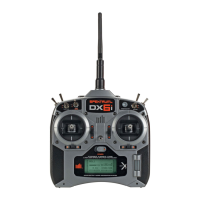issue 65:8
the CRONICLE
Spring 2010
I
a m i n s t r uctionall y c h a l -
lenged. I found the 95 page
owner’s manual for the original
Spektrum DX6 (written as though
fixed-wing aircraft and helicopters were
the only models that would ever use it)
virtually incomprehensible. Fortunately
Chuck Winder wrote a set of DX6
programming instructions for dummies
(i.e., sailors like me who never flew
model airplanes) which was included in
his article entitled “Spektrum DX6 RC
System,” published in Model Yachting in
the spring of 2006.
Recently I had to replace my old
original DX6, and thus I found myself
confronted by the Spektrum DX6i
manual (this time it’s 138 pages long),
and a transmitter that must be pro-
grammed with controls and menus
that differ from those of the original
DX6. Fortunately, the principles are
basically unchanged, and Chuck’s old
set of instructions served as the Ro-
setta Stone that allowed me to translate
from aviator-speak to sailor jargon, and
successfully program the 6i with only
a few epithets and references to the
parentage of the engineers who de-
signed the thing and wrote the manual.
Since I fear I may need to program it
again someday, I made notes about the
steps I took. Perhaps some other 914er
somewhere suffers from a handicap like
mine and will find the following CR
RADIO ACTIVITY
Programming the Spektrum DX6i
by Dick Martin
914-specific programming instructions
helpful. When (if ) you try to read them
‘cold’ they likely will seem at least as
dense as I accuse the DX6i manual of
being. With a live transmitter in your
hands, however, I think you will find it
easy to follow the steps in this DX6i
programming cookbook. Please note,
however, that this ‘recipe’ is not intended
to completely replace the manual. Be
sure to read pp. 6-23 and 136-137 for
important general (and easily compre-
hensible) information about operating
the DX6i system.
Preliminaries
Control stick adjustments – If you,
like me, find horizontal motion of your
sail-control joystick and vertical motion
of your rudder joystick distracting, take
advantage of the method for adjusting
joystick tensions described on page 12
of the DX6i manual. Open the back of
the case (remove six screws); then mark-
edly tighten the “stick tension screw”
for the vertical travel of the left-hand
gimbals (viewed with the transmitter
lying face down) to make it act more like
a normal rudder joystick; then tighten
the screw at the upper right corner of
the right-hand gimbals to restrict lateral
motion of the sail-control joystick. I
found that if I overshot with that screw
it would create too much friction in the
up-down plane as well, so you’ll need
to experiment with it. While you are
at it you may want to tighten the large
tensioning screw running through the
metal strip that is the primary means
of adjusting the feel of the up-down
motion of the sail joystick.
“Binding” – Before the transmitter
can communicate with the receiver they
must be electronically “bound” together
so that the receiver will ‘hear’ encoded
commands from only that transmitter
(actually, commands only from the
specific model memory you assign to
your CR 914 as described in step 1.a.).
Insert the binding plug, power up the
receiver(s), and confirm that the receiver
LED(s) is/are flashing. Center both
joysticks (which will establish a pre-
liminary fail-safe setting—see step 7 for
more information), then pull and hold
the rear switch on the left side of the top
of the transmitter (labeled just “trainer”
rather than “binding/trainer”—thanks
a lot, Spektrum) while you turn on the
power switch. It may take as much as
20 seconds, and you may have to move
the transmitter to another position,
but eventually the blinking LED(s)
will glow steadily to tell you that the
encoding has succeeded. Be sure to re-
move the binding plug before you turn
off the receiver—otherwise the bound
instructions will be lost.
The programming process – All
programming is carried out by either
depressing or rotating a large roller
switch (which rotates a little too easily
past the notch you want when you try
to work too fast). A few minutes of
practice before you set out in earnest
will reduce aggravation later on. When
the transmitter is turned on you will
Editor’s note: In an attempt to inject a little
levity into a somewhat tedious process,
the author may have made the 2.4 GHz
spread spectrum DX6i appear to be poorly
designed and not worth the hassle required
to make it work. Do not be misled! If you
are contemplating switching to a DX6i,
particularly if you presently use a 75 MHz
radio, do not let this article dissuade you
from acquiring this well-engineered instru-
ment which, once you get it programmed,
will greatly improve the quality of your
RC sailing life and those of race manag-
ers and regatta chairs who will no longer
have to worry about channel conflicts with
your radio.
Panel 1

